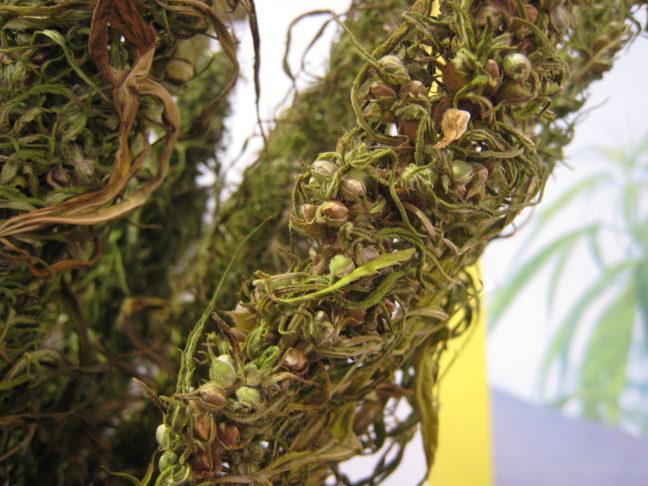The growing hemp industry in Wisconsin presents farmers with a viable alternative, but growers and the general public are taking steps to stay informed and understand the possible risks upon entering the industry.
Given the plant’s close relation to marijuana, University of Wisconsin Department of Horticulture Assistant Faculty Associate Shelby Ellison said both hemp and marijuana belong to the same genus’ species, Cannabis sativa.
The main difference, however, lies in the amount of tetrahydrocannabinol the two plants contain.
THC is the psychoactive component of the plant. In the context of marijuana, it gives users the “high,” director of the Plant Industry Bureau of Wisconsin Department of Agriculture, Trade and Consumer Protection Brian Kuhn said.
A simple way to differentiate the two products is all hemp must have less than 0.3% THC by dry weight, as legally defined in the Hemp Farming Act of 2018. If it exceeds that bar, it is marijuana.
One use of hemp is to produce cannabidiol products. CBD products are legal in Wisconsin, according to Patch.
Ellison added that the production of CBD is only one of the many uses of industrial hemp.
Ellison said that when farmers grow female hemp plants and let them mature without getting pollinated by a male plant, they can then harvest the flowers from which CBD oil is extracted.
When farmers choose to grow both female and male plants in the field, pollination happens, which leads to the production of seeds. These seeds will then be used either for consumption or pressed for oil, Ellison said.
Historically, hemp is often grown for fiber. People grow the plant and chop off the stock that can then be used for things like ropes, textiles and building materials, Ellison added.
According to an article from The Cap Times, Wisconsin led the country in hemp production in the early 1940s. World War II further boosted the demand due to the plant’s utility for making rope. At one point during the war, Wisconsin had 42 hemp mills.
In 1970, industrial hemp was included in the federal Controlled Substances Act with marijuana and became a Schedule I drug. Wisconsin thus banned industrial hemp production in compliance with the act, according to the Cap Times article.
New developments occurred two years ago, which saw the passing of Wisconsin’s industrial hemp bill. With the bill, Wisconsin farmers started growing hemp again in May 2018 under the regulation of DATCP, the article said.
Kuhn said the industrial hemp program currently operating in Wisconsin is under a pilot research program where each grower needs to fill out a research agreement and signs on to be a researcher.
In Wisconsin, DATCP oversees and regulates the hemp industry. Kuhn said, according to federal law, states can create their own hemp programs as long as state legislature passes laws to allow for it.
“The state legislature gave us the authorizing legislation to create the program here in the state,” Kuhn said. “We licence those growers in the state and processors, and then regulate them.”
With regards to hemp production, both Kuhn and Ellison emphasized the importance of monitoring the plant throughout the season.
Ellison said if the hemp plants state farmers grow end up having greater than 0.3% THC at the end of the season — which by definition would categorize them as marijuana — the whole crop has to be destroyed.
“We are really certainly encouraging growers to do their own monitoring throughout the season so that they are tracking that [THC percentage],” Kuhn said.
Ellison said the monitoring process could begin once the plants start flowering. State growers could choose to send sample flowers to a third-party testing place, who will then inform growers of the amount of THC present in their flowers.
Ellison also said the common protocol among Wisconsin growers is to test the amount on a weekly basis to make sure the THC level stays below 0.3%.
When growers fail to take the initiative to get the testing done, DATCP would take over the responsibility.
“Growers could, depending on how close you are monitoring your crop, get to a place where you get a result from the department that says the crop is above the 0.3% THC level and requires destruction,” Kuhn said.
Besides the possible risk of plants exceeding the 0.3% THC level, underdevelopment of the hemp market is another factor growers should take into consideration.
Ellison said the market to sell hemp products has not been very well established, and farmers could face the risk of not having a place to sell their produce.
“Especially [when] a lot of people grow hemp, the processors who are processing CBD oil are going to be selective and only pick the crop with the highest CBD percentage,” Ellison said.
In the upcoming spring semester 2020, Ellison will teach a class at UW, the Science of Hemp. The class will focus on providing students with basic information about the plant and the industry in general.
Ellison said that making sure people are aware of hemp and are educated about it is important.
“Because it is so new, there is no really reliable source of information on the internet,” Ellison said. “ … [We need to] start getting a good basis of legitimate scientific knowledge about the plant and passing it on to the future of the cannabis industry.”


